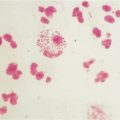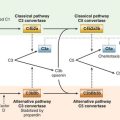CASE 21
Ten-year-old Jimmy is brought to your office by his mother the day after he returned from summer camp, with diffuse blisters over his arms and legs. He has never had these before, and there is no family history of autoimmune disorders. He is not febrile and has taken no medications. Other than these blisters, which are associated with moderately itchy skin, he does not feel ill. How do you determine the underlying cause of the problem and how do you treat it?
QUESTIONS FOR GROUP DISCUSSION
RECOMMENDED APPROACH
Implications/Analysis of Family History
There is nothing presented in this case that would indicate that family history is of significance.
THERAPY
The appropriate therapy here is simply topical corticosteroid creams, which generally produce complete resolution in days. Note that avoidance of poison ivy is crucial because subsequent exposure is likely to produce an even more dramatic reaction (immune memory!).
Agostini C. Tailoring immunosuppressive therapy in interstitial lung diseases. Sarcoidosis Vasc Diffuse Lung Dis. 2004;21:3.
Berentsen S, et al. Favourable response to therapy with the anti-CD20 monoclonal antibody rituximab in primary chronic cold agglutinin disease. Br J Haematol. 2001;115:79.
Borza DB, Neilson EG, Hudson BG. Pathogenesis of Goodpasture’s syndrome: A molecular perspective. Semin Nephrol. 2003;23:522.
Braem PP, et al. Diagnosis of cardiac sarcoidosis and follow up of 24 consecutive patients. Rev Med Interne. 2004;25:357.
Brantley TA. Diagnosing hemolytic disease of the newborn. Clin Lab Sci. 2002;15:140.
Brashington RD, et al. Immunologic rheumatic disorders. J Allergy Clin Immunol. 2003;111:S593.
Chang AB, et al. Effect of inspiratory flow on methacholine challenge in children. J Asthma. 2004;41:349.
Chaves CJ. Stroke in patients with systemic lupus erythematosus and antiphospholipid antibody syndrome. Curr Treat Options Cardiovasc Med. 2004;6:223.
Coker RK. Diagnosing and managing sarcoidosis. Practitioner. 2004;248:246.
Crawford GH, McGovern TW. Poison ivy. N Engl J Med. 2002;347:1723.
Cunard R, Kelly CJ. Immune-mediated renal disease. J Allergy Clin Immunol. 2003;111:S637.
David M, et al. Induction of the IL-13 receptor alpha2-chain by IL-4 and IL-13 in human keratinocytes: Involvement of STAT6, ERK and p38 MAPK pathways. Oncogene. 2001;20:6660.
Engeman TM, et al. Inhibition of functional T cell priming and contact hypersensitivity responses by treatment with anti-secondary lymphoid chemokine antibody during hapten sensitization. J Immunol. 2000;164:5207.
Erlich JH, Sevastos J, Pussell BA. Goodpasture’s disease: Antiglomerular basement membrane disease. Nephrology. 2004;9:49.
Etienne A, et al. Severe hemolytic anemia due to cold agglutinin complicating untreated chronic hepatitis C: Efficacy and safety of anti-CD20 (rituximab) treatment. Am J Hematol. 2004;75:243.
Evans RS, et al. Chronic hemolytic anemia due to cold agglutinins: II. The role of C′ in red cell destruction. J Clin Invest. 1968;47:691.
Fogg MK, Pawlowski NA. Anaphylaxis. Pediatr Case Rev. 2003;3:75.
Goodall J. Oral corticosteroids for poison ivy dermatitis. Can Med Assoc J. 2002;166:300.
Greenough A. Rhesus disease: Postnatal management and outcome. Eur J Pediatr. 1999;158:689.
Hoshi K, et al. Successful treatment of fulminant pulmonary hemorrhage associated with systemic lupus erythematosus. Clin Rheumatol. 2004;23:252.
Hudson BG, et al. Alport’s syndrome, Goodpasture’s syndrome, and type IV collagen. N Engl J Med. 2003;348:2543.
Janson S, Weiss K. A national survey of asthma knowledge and practices among specialists and primary care physicians. J Asthma. 2004;41:343.
Kitamura T, et al. Severe hemolytic anemia related to production of cold agglutinins following living donor liver transplantation: A case report. Transplant Proc. 2003;35:399.
Lamanske RF, et al. Asthma. J Allergy Clin Immunol. 2003;111:S502.
Nelson HS. β-Adrenergic bronchodilators. N Engl J Med. 1995;333:499.
Oddy WH, et al. Ratio of omega-6 to omega-3 fatty acids and childhood asthma. J Asthma. 2004;41:319.
Ovaly E. Late anaemia in Rh haemolytic disease. Arch Dis Child Fetal Neonatal Ed. 2003;88:F444.
Park MC, Park YB, Lee SK. Elevated interleukin-18 levels correlated with disease activity in systemic lupus erythematosus. Clin Rheumatol. 2004;23:225.
Parkinson G. Images in clinical medicine: The many faces of poison ivy. N Engl J Med. 2002;347:35.
Prince JE, Kheradmand F, Corry DB. Immunologic lung disease. J Allergy Clin Immunol. 2003;111:S613.
Ramos-Casals M, et al. Sarcoidosis of Sjögren syndrome? Clues to defining mimicry or coexistence in 59 cases. Medicine (Baltimore). 2004;83:85.
Reich JM. Adverse long-term effect of corticosteroid therapy in recent onset sarcoidosis. Sarcoidosis Vasc Diffuse Lung Dis. 2003;20:227.
Riha RL, Allen RK. Cryptococcosis and sarcoidosis: Strange bed-fellows: A report of five cases. Sarcoidosis Vasc Diffuse Lung Dis. 2004;21:71.
Sampson HA. Utility of food specific IgE concentrations in predicting symptomatic food allergy. J Allergy Clin Immunol. 2001;107:891.
Sampson HA. Food allergy. J Allergy Clin Immunol. 2003;111:S540.
Shah MK, Hugghins SY. Characteristics and outcomes of patients with Goodpasture’s syndrome. South Med J. 2002;95:141.
Steinke JW, Borish L, Rosenwasser LJ. Genetics of hypersensitivity. J Allergy Clin Immunol. 2003;111:S495.
Van Kamp IL, et al. The severity of immune fetal hydrops is predictive of fetal outcome after intrauterine treatment. Am J Obstet Gynecol. 2001;185:668.
Violi F, Loffredo L, Ferro D. Premature coronary disease in systemic lupus. N Engl J Med. 2004;350:1571.
Wensing M, et al. Patients with anaphylaxis to pea can have peanut allergy caused by cross reactive IgE to vicilin (Ara h 1). J Allergy Clin Immunol. 2003;111:420.






